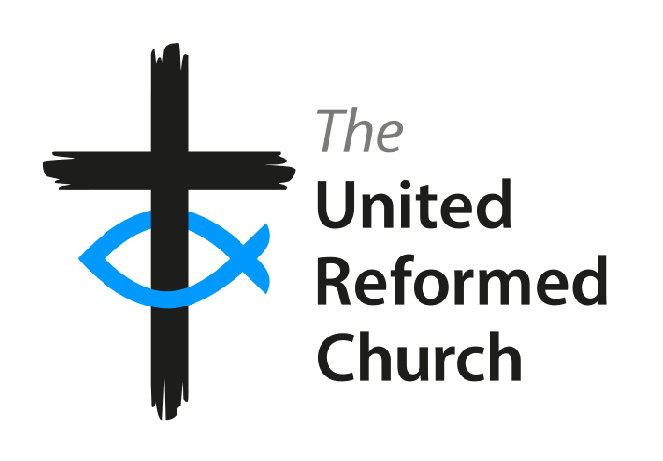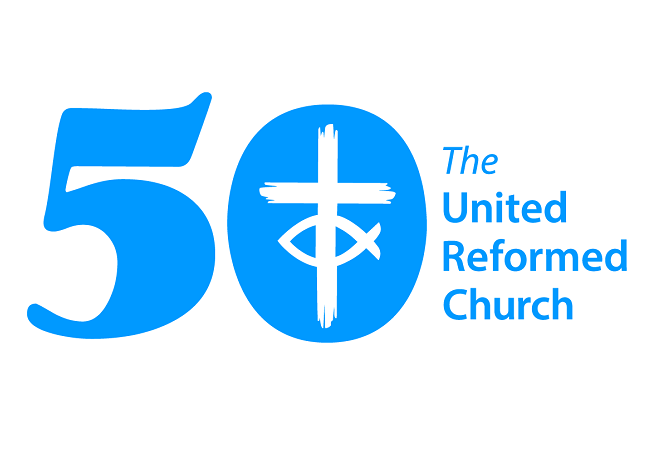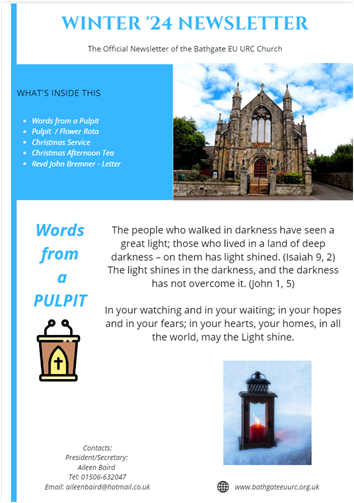Welcome to our church
The United Reformed Church resulted from the 1972 union of the Presbyterian Church of England and the Congregational Church in England and Wales. In introducing the United Reformed Church Bill in the House of Commons on 21 June 1972, Alexander Lyon called it "one of the most historic measures in the history of the Christian churches in this country". About a quarter of English Congregational churches chose not to join the new denomination; in England, there are three main groups of continuing Congregationalists: the Congregational Federation, the Evangelical Fellowship of Congregational Churches and the Fellowship of Independent Evangelical Churches. The URC subsequently united with the Re-formed Association of Churches of Christ in 1981 and the Congregational Union of Scotland in 2000.

History of the Bathgate EU Church
In 1811, Robert Morison became the first minister of the Antiburgher
Secession Church in Marjoribanks Street, Bathgate and on the 14th of
February 1816 a son, James was born in the manse.
The significance of this fact is, that through time, James evolved his ‘New
Views’ against Calvinism, then along with his father and two others, met in
Kilmarnock on the 16th of May 1843 and founded the ‘Evangelical Union’ of
Scotland.
But our church beginnings can be traced further back in time.
Sadly, a definitive history may never be possible because minute books are
only available from 1864. The Church suffered a fire in 1964, which burned
down the vestry and manager’s room. Destroying the archives of the
establishment on this site.
However, I will attempt to give a brief insight into our history and the path
taken to arrive at where we are now, in 2024.
Out of the Scottish Church Life in the 17th and 18th century, came the
Scottish Congregations, who would not succumb to the hierarchy dictating
how they should worship.
These turbulent times created the National Covenant, Praying Societies, the
Secessionist Church, the Burghers and the Antiburghers, Evangelicals and
Congregationalists and eventually the United Reform Church!.
In the early 17th century King Charles I wanted to impose the English form
of worship on Scotland.
This did not go down well with members of the established church and
eventually led to the signing of the ‘National Covenant,’ a manifesto of
protest, believed to have taken place in Greyfriars Kirkyard, Edinburgh, in
1638.
In 1643 a group of nobility and churchmen drew up the Solemn League and
Covenant whereby the Scottish Covenanters would support the overthrow
of King Charles I, on condition that the English adopted a Presbyterian
form of Church government.
However, by 1660, Charles II established Episcopacy i.e. the church ruled
by Bishops in Scotland. Consequently, a number of congregations and
clergy took to the hills to worship.
By 1662, Charles II created an act which proclaimed that permission was
required from a bishop to preach. Then in 1670 another act applied the
death penalty to anyone preaching at open-air meetings or conventicles.
This became known as the Killing Times.
Between 1660 and 1688 18,000 people were either killed, imprisoned, sent
into slavery, or banished for their Presbyterian faith.
And to make matters worse, in 1712 Queene Anne’s Parliament
re-introduced patronage into the church, totally disregarding the Treaty of
Union imposed 5 years earlier. This gave the right to a wealthy patron to
place someone of their choosing to be the minister regardless of the wishes
of the congregation.
A written protest was sent to the General Assembly in 1733 by four
dissidents and a month later they met again and formed the idea of a
Secession Church.
The well-established Praying Societies warmed to the new Secession
Church and on the 5 th of August 1737 the new Church received permission to
use the parish church in Linlithgow to hold a meeting.
The District Societies began to discuss Secession in all its aspects and after
deliberating for a year, in 1738, 15 Elders and 122 members left the
established church and joined the Associate Presbytery, thus formally
creating the ‘Secession Church’.
Among those who left, were a group who had been worshipping at
Craigmailen Farm in the Bathgate Hills and the congregation was
formally initiated “At Knock” within the Parish of Bathgate on Wednesday
November 15th, 1738.
The new congregation held their first service in January 1739 and were
led in worship by Mr John Hunter, the first minister licenced to preach in
the Associate Presbytery. As they did not have a building, a tent was used
consisting of two boards covered with a sheet to create the altar and the
tent was tied to a large stone.
To this day that stone, known as the ‘preachers stane’ has the inscription:
Here preached the first sermon
By ye worthy Mr. Hunter from ye
37th chapter Ezekiel and ye 26 th verse.
This stone is in a field on the land of Upper Craigmailen Farm.
Between 1739 and 1741 the congregation was without a minister. In 1740
there was a large influx of members, and the congregation were given a site
at Craigmailen for a church. The Rev. Andrew Clarkson was ordained as the
first minister of Craigmailen Church at the Knock on 17 th June 1741.
The ‘Secession Church’ prospered until 1747 when a split occurred due to a
new clause added at the Reformation to the oath taken by burgesses.
An oath had to be taken to uphold the ‘True Religion’ (established church).
An interpretation of the new clause was that, by implication, a son could
not succeed to his father’s business without swearing the oath.
While those of the other opinion were known as the “Christian Religion.”
The supporters of these two groups need a new name and
‘Christian Religion’ - Antiburghers
The Antiburghers went on to form the General Associate or Antiburgher
Synod and being in the majority, like the rest of the country, together with
their minister, kept possession of the Church at Craigmailen when the other
side left. Things remained stable until the minister’s death in 1762. The
Rev. Clarkson was succeeded by Rev. Alexander Oliver in 1763. At this time,
the Bo’ness and Mid Calder members left Craigmailen and founded their
own congregations in their respective towns.
By 1807 the building at Craigmailen was in a state of disrepair and was
abandoned, with the minister and the Linlithgow members moving to
Linlithgow and the Bathgate members deciding to move to Bathgate.
The Associate Presbytery of Edinburgh formed the Bathgate people into a
congregation and raised a building for worship on a site, still used today in
Marjoribanks Street, then known as College Street.
A link with the past Church still exists where a carved stone sundial,
brought from the Craigmailen church, was incorporated in the northeast
wall of the old manse.
A minister was called in 1807 but the position was never filled and so it was
not until 1811 that Mr. Robert Morison became the first minister of the
Antiburgher Secession Church in Marjoribanks Street in Bathgate, and
continued as minister until his death on the 5 th of August 1855, aged 72. He
was laid to rest in the graveyard at Bathgate High Parish Church where his
headstone can be found.
James Morison was born in the Church manse in 1816 and while growing
up, his spiritual mind developed, and he evolved his ‘New Views’ which
conflicted with the prevailing Calvinism and he was suspended from the
United Secession ministry in June 1841 for holding such heretical ideas.
The following year his father Robert was also suspended, for coming under
the influence of his son’s theology. In 1843 the same fate befell the Rev.
Alexander Rutherford of Falkirk and the Rev. John Guthrie of Kendal. Thus,
these four met together in Kilmarnock on the 16 th of May 1843 and founded the
Evangelical Union.
The Evangelical Union claimed freedom from state control, subsidy, and
interference.
By the 1880s James Morison’s views were widely recognised by the organised
church life of Scotland and by the close of the 19 th Century there were some 90
Churches. Indeed, Glasgow University conferred on him the degree of ‘Doctor
of Divinity’ acknowledging the esteem in which his theology was held.
In 1875 moves were afoot to purchase the grounds of the existing Church in
Marjoribanks Street. Work on the new building started in 1894, designed by
James Fairley, architect, from West Calder. The memorial stone was
consecrated and laid by Professor Simpson on the 9 th of March 1895.
On Thursday 15 th August 1895, the E.U. doors were opened, and the church was
dedicated by the Rev. William Kirk, assisted by the Rev. David Graham.
Yet another momentous change in the life of our Church came a year later when
the Evangelical Union began discussions with the Scottish Congregational
Church to consider a merger
It was March 1895 before a draft constitution was written for consideration and
seventy-six Congregational and sixty E.U. Churches, discussed the basis of a
draft union. The E.U. Churches were already in agreement to unite based on the
draft proposal, but the Congregationalists deferred the decision for a year.
In April 1896 at the A.G.M. of the Congregational Union in Glasgow the vote
was taken with 144 for and 33 against the union. Then in October 1896,
separate conferences took place within the individual churches and votes taken,
resulting in:
Congregational Union, 93 for, 17 against. And the E.U. 140 for and 14 against.
Therefore, the motion was passed declaring the union of the two Churches from
Jan 1st , 1897.
Our Church in Bathgate entered whole-heartedly into the new union with
Mr. George Wolfe, secretary of the Bathgate E.U. Church being appointed the
treasurer of the Congregational Union in Scotland.
Once again, our church in Bathgate did not want to sever its roots with the past
and proudly continued to proclaim itself as the Church of the E.U.
Congregational Union.
However, in 1994 at the general assembly it was decided, for charitable status
reasons, to call the ‘Union’ a ‘Church’ making it ‘Congregational Church in
Scotland’. Bathgate became known as the ‘E.U. Congregational Church in
Scotland.’
With the dust hardly settled on that affair, a new union was in the offing, with
the United Reformed Church. In September 1998, the Congregational Church in
Scotland discussed a proposed union with the ‘United Reformed Church in the
United Kingdom’.
In 2000 the Unifying Assembly of the ‘Congregational Church in Scotland’ and
the ‘United Reformed Church in the United Kingdom’ united to form the
‘United Reformed Church.’
Evangelical Union in Scotland
In 1811 Mr. Robert Morison became the first minister of the Antiburgher
Secession Church in Marjoribanks Street in Bathgate, and continued as minister
until his death on the 5 th of August 1855, aged 72.
His son, James was born in the Manse in 1816 and as his spiritual mind
developed, they conflicted with the prevailing Calvinism. He was eventually
suspended from the United Secession ministry in June 1841.
James along with his father and two others met in Kilmarnock on the 16 th of May
1843 and founded the Evangelical Union.
The Evangelical Union claimed freedom from state control, subsidy, and
interference.
The Congregational Church in Scotland
The story of Congregationalism begins with Robert Haldane, who was a lay
preacher, and his brother James Haldane.
They tried to generate the need for missionary effort at home and abroad.
To do this they made preaching journeys and established Sunday schools.
They could not promote this because of hostility from ecclesiastical courts, and
in 1811 along with other like-minded associates, decided to form a new
denomination.
But the real architect of Scottish Congregationalism was the Rev. Greville
Ewing, a Church of Scotland minister who left that Church and joined forces
with the Haldanes. Thus establishing ‘The Congregational Union in Scotland’ in
1812.
He went on to become the founder of the Glasgow Theological Academy and
became its Principal.
James Morison (1843 – 1891, ‘son of our manse’) was the principal at the
Evangelical Union Theological Hall.
Eric Liddell (The flying Scot) was a missionary in China from 1925, aged 23
until his death in 1945 in a Japanese Internment camp, 5 months before
liberation.
David Livingstone was a missionary and physician (1813 – 1873).
Famous as an explorer, particularly Africa. He was obsessed with finding the
source of the river Nile. He was instrumental in stopping the slave trade in East
Africa and Founded many major Christian missionary initiatives.
United Reformed Church
The U.R.C. came into being in 1972, in England with the union of the
Congregational Church in England and Wales and the Presbyterian church of
England.
The English Congregational Church was established in the 17 th century and
believed that the running of each congregation lay in the hands of the members.
The Presbyterian Church also came into being in the 17 th century but had
declined in England, though not in Scotland.
In 1981 these two partners were joined by the reformed Churches of Christ.
This Church started in the 19 th century in the U.S.A.
In 2000 the ‘Congregational Church in Scotland’ united with the ‘U.R.C in the
United Kingdom’ to form the ‘United Reformed Church’.
Who is in the Pulpit this week
and Flower Rota
Find a list of ministors that will leading our services.
Service @ 11am and Communion first Sunday of the month.
| Date | Pulpit | Flowers |
|---|---|---|
| 5th October 2025 | Mr Donnie Caldwell | Mrs M Stewart |
| 12th October 2025 | Revd. Helen Mee | Mrs N Christie |
| 19th October 2025 | Mrs Liz Orr | Mrs R Clarke |
| 26th October 2025 | Revd. Jan. Adamson | Mrs M McLaughlin |
| 2nd November 2025 | Revd. Helen Mee | Mr R Harkness |
| 9th November 2025 | Mr Donnie Caldwell | Mrs S Earl |
| 16th November 2025 | Revd. Helen Mee | Mrs M Stewart |
| 23rd November 2025 | Mrs Liz Orr | Mrs D Arthur |
| 30th November 2025 | Worship Group | Mrs A Main |
| 7th December 2025 | Worship Group | Mrs T Peacock |
| 14th December 2025 | Worship Group | Mrs E Young |
| 21st December 2025 | Worship Group | Mrs N Christie |
| 28th December 2025 | Worship Group | Mrs A Main |
Church Notice
-
Church ABM May 2023 - Accounts
Find the Document HERE
URC Info & Local info
Hall Lets
Our hall is available for let.
It is available Morning(9am/12 Noon), Afternoon(1PM/5pm) and Evenings(6pm/9pm). (£25 per Hour)
We have a large hall with stage facilities, kitchen, toilets and seating with or without tables.

If you are interested in booking the hall, please contact us for more information. Tel:01506-632047
Email: info@bathgateeuurc.org.uk
Contact Us
Church President & Secretary
Aileen Baird
01506 - 632047
alieenbaird@hotmail.co.uk





